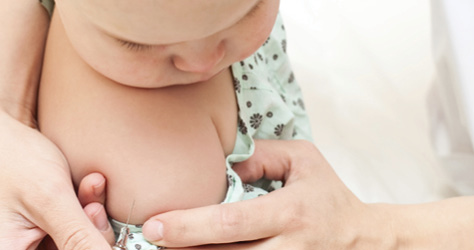Your baby will be protected from eight childhood diseases during their first year.
Find out exactly what to expect and when, with our guide to the vaccination schedule.
At a glance
- Some immunisations require multiple doses
- They aren't all injections, some are drops in the mouth

It's less confusing than you might think
When they’re in the womb, babies have a little bit of immunity to illnesses, but this gradually wears off when they arrive in the world. So it’s vital to follow their immunisation schedule, as listed in the Red Book. Yes, it can look a bit overwhelming but most mums find the experience less scary than they’d imagined. And, of course, it helps to remember that you’re doing your bit to protect your little one from some pretty nasty illnesses.
Why are babies immunised?
When you catch an infectious disease, your body produces antibodies to fight it off. With immunisations, a baby is given an altered form of a disease.
They will not get the disease itself, because it’s given in such a weak (or dead) form. But their body will produce antibodies to it, just as if it were the real thing.
This means, if your baby later comes into contact with the real disease, they will already have the antibodies in their system to fight it off. They either won’t get it at all or will get it in a very mild form.
Childhood immunisations are free. Once your baby has all their childhood jabs, they will be protected against:
Diphtheria: A rare but dangerous disease that can cause severe breathing difficulties in children.
Flu: Symptoms of flu in children can be the same as for adults – including fever, chills and stuffy noses. Some children can develop a high fever or complications if they catch it.
Hepatitis B: This virus is a major cause of serious liver disease and since August 2017 all babies are given three doses as part of the 6-in-1 vaccine.
Hib: This bacterial infection can cause several serious diseases, including meningitis and pneumonia.
Measles: A serious infectious illness that can lead to many complications.
Meningitis B: Another form of meningitis, this vaccine was introduced in September 2015.
Mumps: An illness that causes swollen glands in the neck and can lead to serious complications, such as deafness and infertility.
Pertussis (whooping cough): A serious and prolonged illness affecting the airways.
Pneumococcal infection: A dangerous bacterial infection that causes blood poisoning, meningitis and pneumonia.
Polio: A virus that can cause permanent paralysis or death. Polio is rare in the UK, but it can be caught abroad.
Rotavirus: A highly infectious bug causing diarrhoea and sickness in babies.
Rubella (German measles): This illness causes a rash and sore throat. If women are not immune and catch it in the first three months of pregnancy, there is a risk that their baby will be born with birth defects.
Tetanus: A serious illness affecting the nervous system.
Here’s what they get and when:
At 8 weeks
- First dose of the 6-in-1 injection which protects against diphtheria, tetanus, whooping cough (pertussis), polio and Hib (haemophilus influenza type B) and Hepatitus B.
- First dose of the Rotavirus vaccination, given as a liquid dropped straight into the baby’s mouth. It protects against rotavirus infection, a common cause of diarrhoea and sickness
- Meningitis B injection which protects against the B strain of meningitis
All these vaccinations are usually given in the same visit; get advice from your GP practice if your child isn’t well that day
At 12 weeks
- Second dose of the 6-in-1 injection
- Second dose of the rotavirus vaccine
- Pneumococcal injection, which protects against the main types of bacteria that can cause septicaemia and meningitis
At 16 weeks
- Third (and last) dose of the 6-in1 injection
Phew, you’re all done now until just after their first birthday when it will be time to fish out the Red Book out again ready for the next bit of their immunisation schedule.